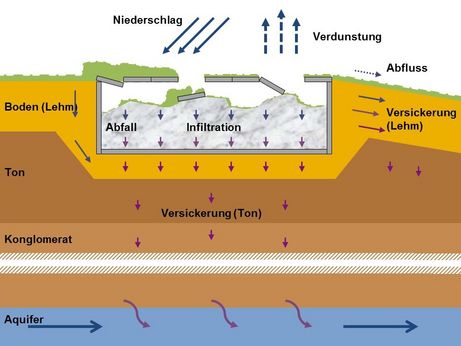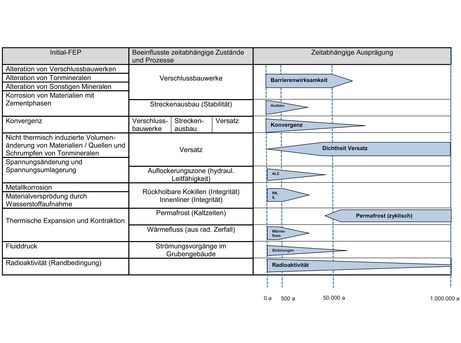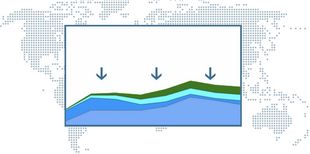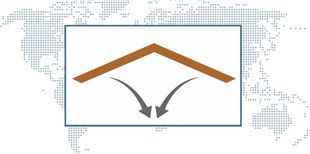Long-term safety studies


The key objective of radioactive waste disposal is the long-term protection of man and the environment against the harmful effects of radioactive substances. Long-term safety analyses are to demonstrate that the proposed disposal and repository concept can meet this target and the respective requirements. The safety assessments require a complete description of the repository system consisting of the mine, the emplaced waste, the geosphere, and the adjacent biosphere (FEP catalogue). The future development of the repository system can be determined from the interactions between the repository system components or features and various relevant processes and events (scenario development).
Especially for geological repositories, it is necessary to carry out structural analyses for the modelling of the long-term development of the repository and its environment. To this end, suitable constitutive models for the host rock and the building materials need to be developed. These have then to be integrated into simulation programs, followed by validation calculations. We usually carry out this work in the course of generic R&D projects. We then use existing and proven models and programmes for existing mine projects, especially for BGE’s mines as discussed below. When applied to different host rocks and repository concepts, specific safety demonstration concepts have to be developed in each case. Important elements of the safety analyses are integrity analyses of the geotechnical and geologic barriers. For this purpose, system analyses with coupled physical processes have to be carried out. The development of the necessary simulation models requires very good knowledge of the calculation programmes and of the basic data; e.g. of the host rock and the repository concept. Furthermore, defined standards, such as comparability of the results and level of detail of the calculations, must be met. We develop models for long-term safety analyses, implement them into corresponding simulation programmes, and apply them to generic and specific cases. The radiological assessment of the expected development of the repository system is based on a radiological consequences analysis. Further numerical tools to evaluate the results of the model calculations are sensitivity and robustness analyses. Due to our participation in national and international waste management and research projects, we have extensive experience in the field of repository safety and are always up-to-date with regard to safety demonstration methodology.
References
- CHRISTA-III: Development of a methodology for the systematic derivation of expected and deviating developments in crystalline rock in Germany and exemplary application as a basis for assessing safe containment considering optimization measures (2022 - 2025)
- BARIK: Development and testing of an extended Hoek-Brown material model to account for anisotropic strength behavior in the application of integrity criteria for crystalline host rocks (2021 - 2024)
- RANGERS: Development of a guideline for the design and verification of geotechnical barriers for a high-level radioactive waste repository in salt formations (2019 - 2023)
- KOMPASS-II: Compaction of salt gravel for secure confinement - Phase 2 (2021 - 2023)
- SUSE: Safety analytical investigations into repository systems in crystalline formations (2017 - 2023)
- ANSICHT-II: Update of the safety and verification methodology for high-level radioactive waste disposal in claystone in Germany (2018 - 2022)
- CHRISTA-II: Development of a safety and verification concept for a repository for heat-generating radioactive waste in crystalline rock in Germany (2017 - 2021)
- BASEL: Assessment of the dependencies between the safe construction and operation of a repository for heat-generating waste and long-term safety (2016 - 2020)
- MONTANARA: Development of monitoring concepts based on safety and verification concepts, as well as derivation of decision criteria and response options (2015 - 2019)
- KOSINA: Concept developments for a generic repository for heat-generating waste in bedded salt formations in Germany (2015 - 2018)
- SAnToS: Investigation on long-term safety aspects of a radioactive waste repository in a diagenetic clay formation (2012 - 2017)
- ProSiD: Process simulation for the design of support and sealing elements for shaft closures (2012 - 2016)
- CHRISTA: Feasibility study for the development of a safety and verification methodology for a repository for heat-generating waste in a crystalline rock formation in Germany (2015 - 2016)
- VerA, Phase II: Compensation of the fractured zone in the salt mine (VerA) Phase II - Generation of crack systems in a fractured zone at the grain size scale and transfer of results to the macro level for simulation of an injection process (2012 - 2015)
- REPOPERM-II: Remaining porosity and permeability of compacted crushed rock salt backfill in a HLW repository, Phase II (2010 - 2014)
- P&T: The impact of partitioning and transmutation on repository concepts and the long-term safety of repositories for heat-generating radioactive waste. (2012 - 2013)
- TEMTON: Investigations on THM effects in Buffer EDZ and Argillaceous Host Rock (2006 - 2013)
- VSG: Preliminary safety analysis for the Gorleben site (2010 - 2012)
- VerA: Compensation of the fractured zone in the salt dome (2009 - 2011)
- THERESA-MOLDAU: Verification and calibration of a THM model to describe the long-term behavior of the excavation damaged zone in rock salt (2006 - 2009)
- MACH-2: Feasibility study for the preparation of a twin hole disposal configuration test at the Mont Terri URL (2008 - 2009)
- REPOPERM: Residual porosity and permeability of compacted salt gravel backfill in a high-level radioactive waste repository (2007 - 2009)
- TEE: Investigation on thermal expansion effects in clay formations (2001 - 2006)
- ÜBERSICHT: Transfer of the safety verification concept for a repository in salt to other host rocks (2001 - 2006)
- GEIST: Comparison of repository concepts in salt and claystone (2001 - 2004)









